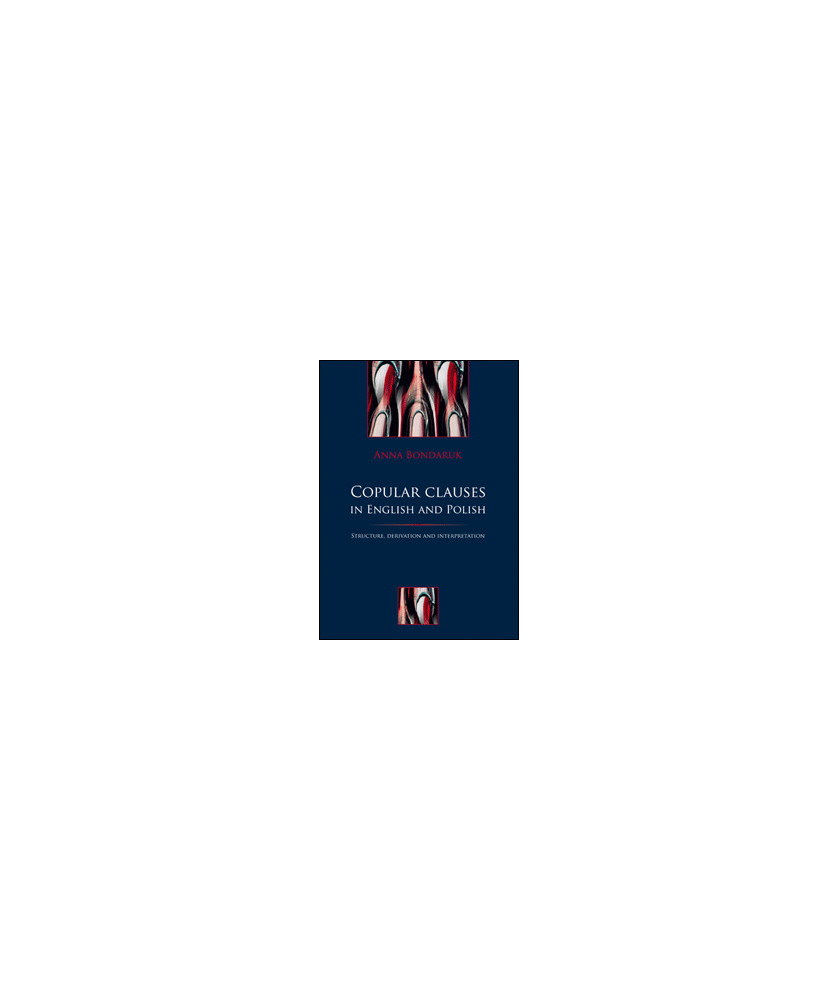


Anna Bondaruk
ISBN: 978-83-7702-641-0
Stron: 374
Format: B5 (oprawa twarda)
Rok wydania: 2013
TABLE OF CONTENTS
Acknowledgements
List of abbreviations
Introduction
PART I
Copular clauses in English
Chapter I. The taxonomy of copular clauses in English
1. Introduction
2. Higgins' taxonomy of copular clauses
3. Roy's (2006) distinction in the predicational class
4. Syntactic tests to distinguish particular classes of copular clauses
5. Reducing the number of copular clauses in Higgins' taxonomy
5.1. Eliminating identificational copular clauses
5.1.1. Mikkelsen (2004, 2005)
5.1.2. Heller and Wolter (2008)
5.2. Eliminating specificational copular clauses
5.2.1. Specificational clauses as inverted predicational sentences
5.2.2. Specificational clauses as equatives
5.3. Eliminating equatives
6. Summary
Chapter II. Predicational and specificational clauses in English
1. Introduction
2. Differences between predicational and specificational clauses
3. Information structure of predicational and specificational clauses
4. Arguments for and against predicate raising in specificational clauses
5. Restrictions on the subject of specificational clauses
5.1. What can and cannot be a specificational clause subject
5.2. Why some indefinites can, and some others cannot, be specificational subjects
5.3. Problematic issues
6. Predicate raising as an instance of A- or A'-movement?
6.1. Arguments for treating predicate raising as an instance of A-movement
6.2. Arguments for treating predicate raising as an instance of A'-movement
6.3. Predicate raising vs. predicate fronting
7. Syntactic derivation of predicational and specificational clauses in English
7.1. Main assumptions
7.2. Syntactic analysis of predicational clauses
7.3. Derivation of specificational clauses in English
7.4. Potential problems
8. Summary
Chapter III. Equatives in English
1. Introduction
2. Equatives - the basics
3. How are equatives different from predicational and specificational clauses?
4. Syntactic analyses of equatives
4.1. English equatives as symmetrical structures
4.2. Asymmetrical structure for English equatives with a special functional head
4.3. Equatives as predicational clauses with special semantics
5. Summary
PART II
Copular clauses in Polish
Chapter IV. Copular clauses in Polish - Their typology and basic characteristics
1. Introduction
2. The traditional grammar view of Polish copular clauses
3. The inventory of copular clauses in Polish
4. Basic syntactic characteristics of Polish copular clauses
5. Higgins' (1979) typology applied to Polish copular clauses
5.1. Predicational, specificational, equative and identificational clauses in Polish
5.2. Syntactic tests to distinguish various classes of copular clauses
6. Summary
Chapter V. Two types of clauses with the copula być 'to be' in Polish
1. Introduction
2. The two types of copular być clauses - Distribution and constraints on use
3. The two types of predicational clauses
4. Case marking of predicative DPs in być copular clauses
4.1. Previous analyses of case marking of predicative DPs in Polish
4.1.1. Bailyn and Citko (1999)
4.1.2. Przepiórkowski (2001)
4.1.3. Citko (2008)
4.2. A new account
4.2.1. Initial assumptions
4.2.2. The structural position of the copula być
4.2.3. Evidence for case agreement in być + DPnom structures
4.2.3.1. Extraction facts
4.2.3.2. Agreement facts
4.2.4. Case agreement as feature sharing
4.2.4.1. Pesetsky and Torrego (2007)
4.2.4.2. Frampton and Gutmann (2000)
4.2.4.3. Restrictions on case agreement
4.2.5. The analysis proper
5. Some alternative analyses of the DP predicate case marking
5.1. Harves (2002)
5.2. Matushansky (2008a)
5.3. Pereltsvaig (2007)
5.4. Roy (2006)
5.5. Interim summary
6. AP predicates in Polish
6.1. AP predicates in Polish
7. Summary
Chapter VI. Predicational to być clauses in Polish
1. Introduction
2. Predicational to być clauses - defining or characterising?
3. The categorial status of to in to być copular clauses
3.1. To as a verb
3.2. To as a pronoun or a functional head
3.2.1. Hentschel's (2001) dislocation analysis of to być copular clauses
3.2.2. Rutkowski's (2006) account
3.2.3. Błaszczak and Geist's (2001) analysis
3.3. Citko's (2008) analysis
3.3.1. Comments on Citko's analysis
3.4. To as a Pred head
3.5. Interim summary
4. Case and agreement in to być predicational clauses
4.1. Agreement patterns in predicational to być clauses
4.2. Person restriction in predicational to być clauses
4.3. The Person Case Constraint
4.4. PCC-based analysis of agreement patterns and person restriction in Polish predicational to być clauses
4.5. Problematic cases
4.5.1. PCC in Polish double object constructions
4.5.2. To być clauses with person mismatch
4.5.3. Inverted structures with person mismatch
4.6. Predicational to być clauses vs. predicational być + DPnom sentences
5. Summary
Chapter VII. Inverse copular clauses in Polish
1. Introduction
2. Two types of inverse copular sentences in Polish - Similarities and differences
2.1. Inverse copular clauses vs. equatives
3. Information structure of Polish inverse copular sentences
3.1. Topic and focus in Polish inverse copular clauses
3.2. Restrictions on the inverted predicate
3.3. Types of post-copular elements
4. A'-position of the inverted predicate
4.1. Case, agreement and binding
4.2. Extraction facts
5. The sentence final position of the subject in Polish inverse copular clauses
5.1. Tajsner's (2008) analysis of the subject final word order
5.1.1. Criticism of Tajsner's account
5.2. Wiland's (2009) remnant movement analysis
5.3. Slioussar's (2007) remnant movement analysis
5.4. The remnant movement analysis of Polish inverse copular clauses
6. Why are there no PCC effects in specificational copular clauses?
7. Inverse być +DPnom clauses
8. Summary3
Chapter VIII. Equatives in Polish
1. Introduction
2. Two types of equatives in Polish
3. Symmetrical structure of Polish equatives
3.1. Pereltsvaig's (2001, 2007) analysis
3.2. Pereltsvaig's analysis applied to Polish
3.3. Less proper equatives.
4. Asymmetrical structure for equatives
5. Summary
Summary and Conclusions
References
Index